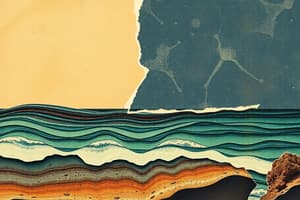Podcast
Questions and Answers
What are the types of transport mechanisms mentioned in the content?
What are the types of transport mechanisms mentioned in the content?
- Traction/Rolling (correct)
- Saltation (correct)
- Solution (correct)
- Suspension (correct)
Under what conditions is net sand transport likely to be onshore?
Under what conditions is net sand transport likely to be onshore?
low wave condition
Longshore sediment transport is important for the removal of sediment from bluffs and cliffs.
Longshore sediment transport is important for the removal of sediment from bluffs and cliffs.
True (A)
Beach drifting primarily results from wave run-up (swash) on the beach ____________.
Beach drifting primarily results from wave run-up (swash) on the beach ____________.
Match the following processes with their descriptions:
Match the following processes with their descriptions:
Flashcards are hidden until you start studying
Study Notes
Coastal Sediment Transport
- Modification of the coast occurs through three processes: erosion, transport, and deposition of material.
- Fine sediments (silt and clay) are placed in suspension and diffuse uniformly through the water column, maintained by turbulence.
- Fine sediments are removed offshore or alongshore, settling out of suspension in deep water, or brought into estuaries, bays, and lagoons where they are deposited in quiet water.
- Four types of transport mechanisms exist: solution, suspension, saltation, and traction/rolling.
- Coarser particles of sand and gravel are exchanged between the inner nearshore and surf zones and the beach, and may be transported alongshore in appreciable quantities.
On-Offshore Sand Transport
- Onshore and offshore transport tends towards an equilibrium or balance over a period of months or years.
- Offshore movement dominates during periods of intense storms, and onshore movement during non-storm conditions.
- The net transport at any elevation can be obtained from integrating the co-spectrum of velocity and sediment concentration.
Sediment Transport Modelling
- Net Shore Drift (NSD) can be determined by considering the direction from Teluk Chempedak to Kuala Pahang.
Sediment Transport under Low and High Wave Conditions
- Under low waves, little sediment reaches high enough to be moved in the offshore direction, and net transport is likely to be onshore.
- Under high waves, sediment will reach higher into the water column, and the strength of the undertow will increase, resulting in a change in the direction of net transport from onshore to offshore.
Measurement of Sediment Transport
- Methods for measuring sediment transport include water filtration, streamer trap, OBS – Orbital Backscatter, and LISST – Laser In-Situ Scattering and Transmissometry.
Longshore Sand Transport
- Longshore sediment transport results from the operation of three sets of processes: beach drifting, surf zone transport, and transport seaward of the breaker zone.
- Beach drifting occurs on the swash slope, driven primarily by oblique wave action.
- Surf zone transport occurs through wave-generated longshore currents.
- Transport seaward occurs through residual tidal currents and wind-driven currents.
Importance of Longshore Transport
- Longshore sediment transport is extremely important on most coastlines, playing a crucial role in the removal of sediment from the base of bluffs and cliffs, and in the creation of beach and dune systems.
- The direction of net longshore sediment transport can be manifested from natural features and by the accumulation of sediment behind obstacles such as breakwalls and groynes.
Littoral Sediment Budget and Littoral Drift Cells
- The littoral sediment budget is an accounting technique that assesses the volume (or mass) of all sediment inputs (sources) and outputs (sinks) to and from the beach and nearshore zone.
- A source can be defined as a point source (e.g. river mouth) or a line source (e.g. cliff erosion).
- Littoral cells are sections of coast that contain a source, or sources of sediment, a well-defined and continuous zone of alongshore sediment transport, and a downdrift sink or zone where sediment is either deposited or lost offshore.
Studying That Suits You
Use AI to generate personalized quizzes and flashcards to suit your learning preferences.



